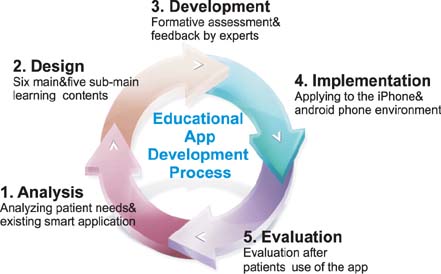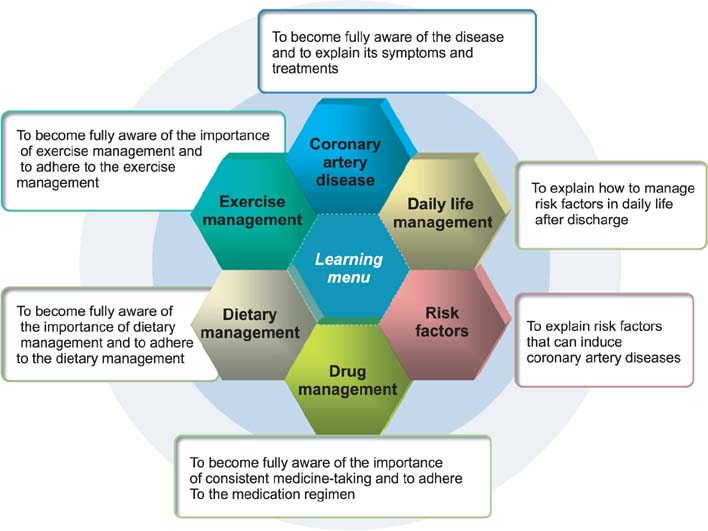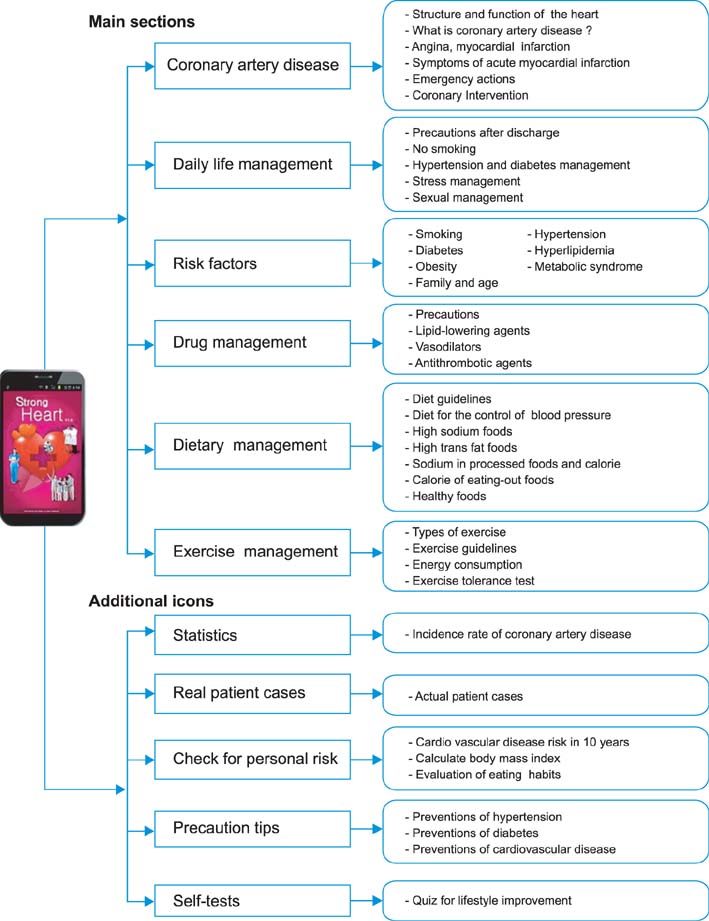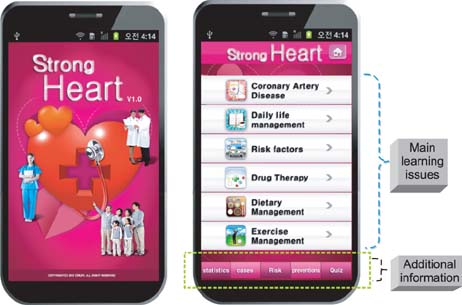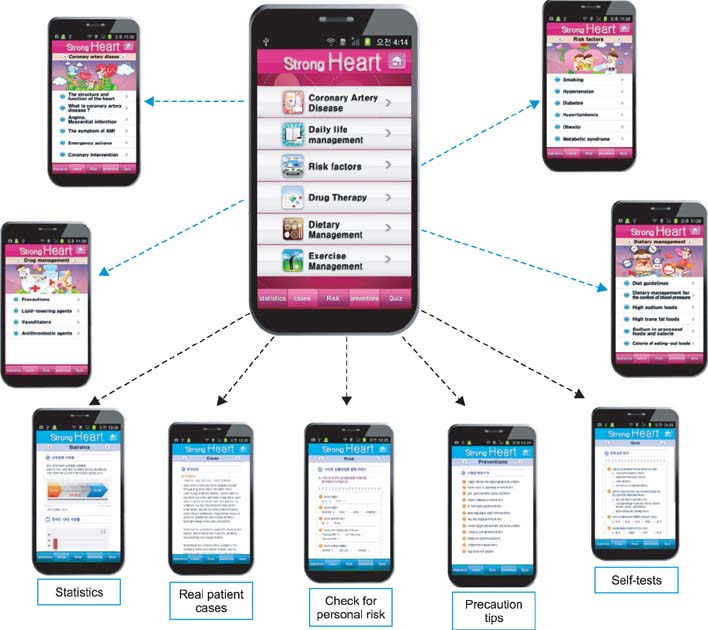Healthc Inform Res.
2014 Apr;20(2):117-124. 10.4258/hir.2014.20.2.117.
Development of Smartphone Educational Application for Patients with Coronary Artery Disease
- Affiliations
-
- 1Department of Cardiology, Chonnam National University Hospital, Gwangju, Korea.
- 2College of Nursing, Hanyang University, Seoul, Korea. seon9772@hanyang.ac.kr
- KMID: 2284571
- DOI: http://doi.org/10.4258/hir.2014.20.2.117
Abstract
OBJECTIVES
This study was conducted to develop a smartphone application (app) as an educational learning instrument for coronary artery disease (CAD) patients and to assess the users' level of satisfaction.
METHODS
This methodological research involves elicited learning content for CAD patients to develop a learning instrument using the smartphone app. The app was developed according to the steps of Assessment, Design, Development, Implementation, and Evaluation, which is a systematic instructional design model. The levels of satisfaction with the developed smartphone app among 30 outpatients with CAD were assessed via a questionnaire during their visits to a cardiology outpatient department.
RESULTS
A smartphone app 'Strong Heart' was developed through reviewing the literature associated with education for CAD patients under professional supervision and searching for medical smartphone apps that are already available. The learning contents include six main sections containing essential learning issues in managing CAD and additional information to attract the user's attention, such as patient cases and quizzes. After modification with feedback from experts, the app was finally developed and evaluated by patients who reported that they were satisfied with the usefulness of the app.
CONCLUSIONS
The developed smartphone app is available on both the iPhone App Store and the Android Play Store. Patients with CAD may utilize the app for supporting educational material without limitations of time and space.
MeSH Terms
Figure
Cited by 3 articles
-
Social Media in Clinical Practice
Mona Choi
Healthc Inform Res. 2015;21(2):138-140. doi: 10.4258/hir.2015.21.2.138.Qualitative assessment of atopic dermatitis-related mobile applications in Korea
Dahee Jin, Tae Hoon Heo, Yoon Lee, Ji-Tae Choung
Allergy Asthma Respir Dis. 2014;2(5):370-376. doi: 10.4168/aard.2014.2.5.370.The Impact of Patient Education with a Smartphone Application on the Quality of Bowel Preparation for Screening Colonoscopy
JeongHyeon Cho, SeungHee Lee, Jung A Shin, Jeong Ho Kim, Hong Sub Lee
Clin Endosc. 2017;50(5):479-485. doi: 10.5946/ce.2017.025.
Reference
-
1. Korea Ministry of Health and Welfare, Statistics Portal. Patient survey in 2009 [Internet]. Sejong: Ministry of Health and Welfare;c2009. cited at 2014 Mar 15. Available from: http://stat.mw.go.kr.2. Sim DS, Kim JH, Jeong MH. Differences in clinical outcomes between patients with ST-elevation versus non-ST-elevation acute myocardial infarction in Korea. Korean Circ J. 2009; 39(8):297–303.
Article3. Son YJ. The development and effects of an integrated symptom management program for prevention of recurrent cardiac events after percutaneous coronary intervention. J Korean Acad Nurs. 2008; 38(2):217–228.
Article4. Chow CK, Jolly S, Rao-Melacini P, Fox KA, Anand SS, Yusuf S. Association of diet, exercise, and smoking modification with risk of early cardiovascular events after acute coronary syndromes. Circulation. 2010; 121(6):750–758.
Article5. Cobb SL, Brown DJ, Davis LL. Effective interventions for lifestyle change after myocardial infarction or coronary artery revascularization. J Am Acad Nurse Pract. 2006; 18(1):31–39.
Article6. Cho HY, Kim HS. Effects of individualized cardiac health education on self-care behavior and serum cholesterol in patients with coronary artery disease. J Korean Acad Adult Nurs. 2010; 22(3):322–328.7. Kang MK, Son KH, Lee GN. Effects of a program using video-audio media on knowledge level and compliance of sick role for patients undergoing coronary angiography. J Korean Acad Soc Nurs Educ. 2011; 17(1):100–109.
Article8. Song MR. Analytic study of design and development process of courseware for health education of patients with hyperlipidemia. Ewha Educ Collect Treatise. 2002; 13:259–269.9. Yonhap News. S. Korea tops smartphone penetration rate in 2012 [Internet]. Seoul: The Korea Herald;c2013. cited at 2014 Mar 15. Available from http://www.koreaherald.com/view.php?ud=20130625000550.10. Sim YB. Factors related to the intent to use the medical application (M-APP) smartphone of hospital employees. Korean J Health Policy Adm. 2012; 22(2):249–262.
Article11. Park MK. 'Health in my hands' smartphone application boom [Internet]. Seoul: Kormedi.com;c2012. cited at 2014 Mar 15. Available from: http://www.kormedi.com/news/article/1197370_2892.html.12. Kim YG, Lee DH. Smartphone application market trend analysis of the country domestic and other countries. KIISC Review. 2011; 21(1):26–37.13. Lee SH, Lim MJ, Lee KY. Healthcare application modeling using smartphone. J Inst Webcast Internet Telecommun. 2010; 10(4):35–40.14. Jeon MK, Ha JY. Effects of a smart phone weight loss program on obesity and body composition in adolescents. J Korean Acad Public Health Nurs. 2013; 27(1):102–112.
Article15. Heo JS, Chun MS, Lee KY, Oh YT, Noh OK, Park RW. Effects of a smartphone application on breast self-examination: a feasibility study. Healthc Inform Res. 2013; 19(4):250–260.
Article16. Seels B, Richey R. Instructional technology: the definition and domains of the field. Washington (DC): Association for Educational Communications and Technology;1994.17. Kim EJ, Hwang SY. Development of Web-based learning program on cardiopulmonary emergency care focused on clinical scenarios. J Korean Acad Adult Nurs. 2010; 22(1):70–79.18. Marcano Belisario JS, Huckvale K, Greenfield G, Car J, Gunn LH. Smartphone and tablet self-management apps for asthma. Cochrane Database Syst Rev. 2013; 11:CD010013.19. American Heart Association. Heart disease, stroke risk estimator app now available for health care professionals [Internet]. Dallas (TX): American Heart Association;c2014. cited at 2014 Mar 15. Available from: http://newsroom.heart.org/news/heart-disease-stroke-risk-estimator-app-now-available-for-health-care-professionals.
- Full Text Links
- Actions
-
Cited
- CITED
-
- Close
- Share
- Similar articles
-
- Effectiveness of Smartphone Application in Histology Practice
- Effects of Self-Education on Patient Safety via Smartphone Application for Self-Efficacy and Safety Behaviors of Inpatients in Korea
- Spontaneous Coronary Artery Dissection and Woven Coronary Artery: Three Cases and a Review of the Literature
- Recent Advances in Percutaneous Coronary Intervention in Coronary Artery Disease
- A Case of Single Coronary Artery c Effort Angina

